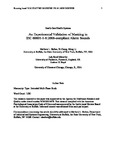An Experimental Validation of Masking in IEC 60601-1-8:2006-compliant Alarm Sounds
| dc.contributor.author | Bolton, M | |
| dc.contributor.author | Zheng, XI | |
| dc.contributor.author | Meng, L | |
| dc.contributor.author | Edworthy, Judy | |
| dc.contributor.author | Boyd, A | |
| dc.date.accessioned | 2019-08-02T11:06:57Z | |
| dc.date.issued | 2019-08-14 | |
| dc.identifier.issn | 0018-7208 | |
| dc.identifier.issn | 1547-8181 | |
| dc.identifier.uri | http://hdl.handle.net/10026.1/14738 | |
| dc.description.abstract |
<jats:sec><jats:title>Objective</jats:title><jats:p> This research investigated whether the psychoacoustics of simultaneous masking, which are integral to a model-checking-based method, previously developed for detecting perceivability problems in alarm configurations, could predict when IEC 60601-1-8-compliant medical alarm sounds are audible. </jats:p></jats:sec><jats:sec><jats:title>Background</jats:title><jats:p> The tonal nature of sounds prescribed by IEC 60601-1-8 makes them potentially susceptible to simultaneous masking: where concurrent sounds render one or more inaudible due to human sensory limitations. No work has experimentally assessed whether the psychoacoustics of simultaneous masking accurately predict IEC 60601-1-8 alarm perceivability. </jats:p></jats:sec><jats:sec><jats:title>Method</jats:title><jats:p> In two signal detection experiments, 28 nursing students judged whether alarm sounds were present in collections of concurrently sounding standard-compliant tones. The first experiment used alarm sounds with single-frequency (primary harmonic) tones. The second experiment’s sounds included the additional, standard-required frequencies (often called subharmonics). T tests compared miss, false alarm, sensitivity, and bias measures between masking and nonmasking conditions and between the two experiments. </jats:p></jats:sec><jats:sec><jats:title>Results</jats:title><jats:p> Miss rates were significantly higher and sensitivity was significantly lower for the masking condition than for the nonmasking one. There were no significant differences between the measures of the two experiments. </jats:p></jats:sec><jats:sec><jats:title>Conclusion</jats:title><jats:p> These results validate the predictions of the psychoacoustics of simultaneous masking for medical alarms and the masking detection capabilities of our method that relies on them. The results also show that masking of an alarm’s primary harmonic is sufficient to make an alarm sound indistinguishable. </jats:p></jats:sec><jats:sec><jats:title>Application</jats:title><jats:p> Findings have profound implications for medical alarm design, the international standard, and masking detection methods. </jats:p></jats:sec> | |
| dc.format.extent | 954-972 | |
| dc.format.medium | Print-Electronic | |
| dc.language | en | |
| dc.language.iso | en | |
| dc.publisher | SAGE Publications | |
| dc.subject | audition | |
| dc.subject | medical devices and technologies | |
| dc.subject | patient safety | |
| dc.subject | psychophysical methods | |
| dc.subject | signal detection theory | |
| dc.subject | Humans | |
| dc.subject | Psychoacoustics | |
| dc.subject | Sound | |
| dc.title | An Experimental Validation of Masking in IEC 60601-1-8:2006-compliant Alarm Sounds | |
| dc.type | journal-article | |
| dc.type | Journal Article | |
| dc.type | Research Support, U.S. Gov't, Non-P.H.S. | |
| plymouth.author-url | https://www.ncbi.nlm.nih.gov/pubmed/31411902 | |
| plymouth.issue | 6 | |
| plymouth.volume | 62 | |
| plymouth.publication-status | Published | |
| plymouth.journal | Human Factors: the journal of the human factors and ergonomics societ | |
| dc.identifier.doi | 10.1177/0018720819862911 | |
| plymouth.organisational-group | /Plymouth | |
| plymouth.organisational-group | /Plymouth/Faculty of Health | |
| plymouth.organisational-group | /Plymouth/Research Groups | |
| plymouth.organisational-group | /Plymouth/Research Groups/Centre for Brain, Cognition and Behaviour (CBCB) | |
| plymouth.organisational-group | /Plymouth/Research Groups/Centre for Brain, Cognition and Behaviour (CBCB)/Behaviour | |
| plymouth.organisational-group | /Plymouth/Users by role | |
| dc.publisher.place | United States | |
| dcterms.dateAccepted | 2019-06-28 | |
| dc.rights.embargodate | 2019-9-11 | |
| dc.identifier.eissn | 1547-8181 | |
| dc.rights.embargoperiod | Not known | |
| rioxxterms.version | Accepted Manuscript | |
| rioxxterms.versionofrecord | 10.1177/0018720819862911 | |
| rioxxterms.licenseref.uri | http://www.rioxx.net/licenses/all-rights-reserved | |
| rioxxterms.licenseref.startdate | 2019-08-14 | |
| rioxxterms.type | Journal Article/Review |


